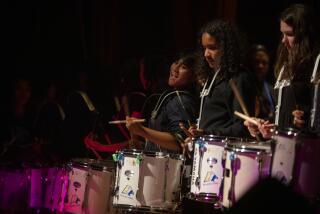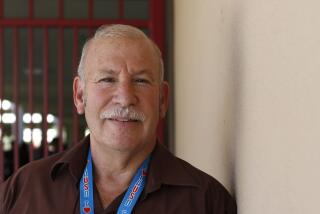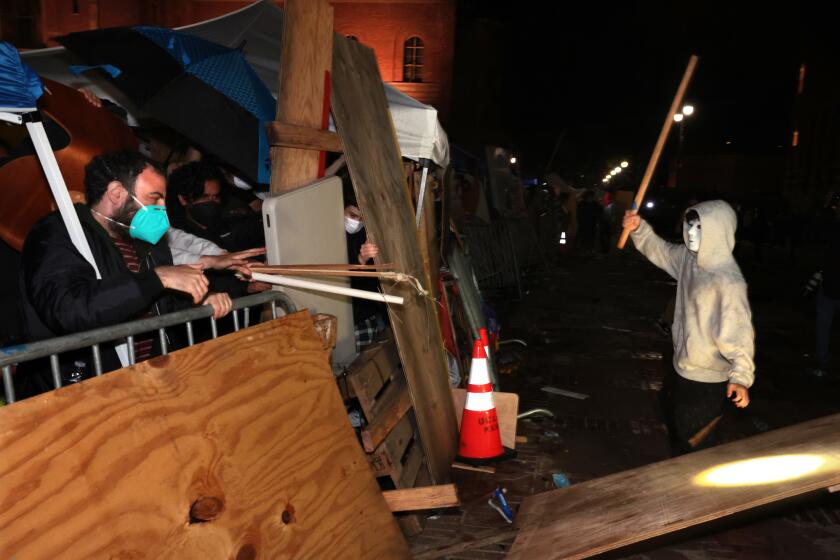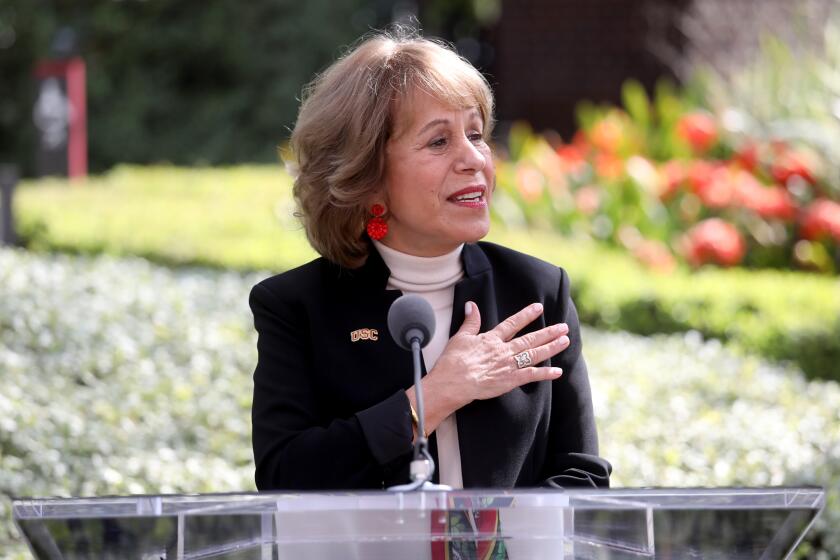Schools Now Plan to Deliver on Promises
Giddy as they counted the last few votes endorsing the largest local school bond ever passed in the United States, Los Angeles Unified School District administrators began scheming Wednesday on how best to spend their $2.4-billion windfall.
The school refurbishment measure seized 71% of the vote--comfortably above the two-thirds approval needed to pass local bond issues--despite a dismal election turnout that had been expected to dash its chances. The same proposal had fallen 1 percentage point short of passage in November.
“How sweet it is,” said Supt. Sid Thompson. “We think [this] is a mandate . . . that people want to see the schools repaired.”
Projects could start later this month, based on agreements previously reached with each school. First up: air-conditioning for three San Fernando Valley campuses, followed within the next month or two by ripples of upgrades starting throughout the district, such as playground repaving, bathroom re-plumbing and fresh coats of paint inside and out.
Eventually, all 800 campuses and school sites are to be touched.
Underscoring the district’s sense of urgency, money to pay for those initial jobs is to be drawn from the district’s $4.9-billion annual budget. The budget will be reimbursed later this year when the first wave of bonds is sold.
The bond measure was the first passed by the nation’s second-largest school system since 1971, when voters agreed to pay for repairs caused by the Sylmar earthquake.
Previously, the biggest school bond ever approved was a $1.5-billion issue embraced by Detroit voters in 1994. That fact alone led to widespread acknowledgment at Los Angeles district headquarters Wednesday that voters need to see tangible results--and soon--for their willingness to dish out more than $60 annually on average in additional property taxes for the next 40 years.
“The voters put aside their concerns” about the district, said bond chairman Richard Katz. “That puts a tremendous amount of pressure on the school board to deliver.”
Grant High School senior Chris Damschroder said installation of new air conditioners for his Van Nuys school can’t come soon enough. He recalled dozing off during summer school classes last year--not because he was was bored, but because it was so hot.
“This is something the school really needs,” said Damschroder, 18, who voted for the bond. The bond’s passage is certain to further fuel Los Angeles’ economic recovery by increasing construction jobs and bringing profits for building materials suppliers, said Jack Kyser, chief economist with the Economic Development Corp., a private, nonprofit organization dedicated to creating jobs.
Over the expected decade or so of construction financed by the bond, projects would annually create about 370 construction jobs and about 650 jobs for suppliers and other workers, according to Ben Bartolotto, an industry analyst for the Construction Industry Research Board.
With that prospect in mind, donations to the Proposition BB campaign from some building and trade unions jumped significantly for the April election. The Southern California Pipe Trades, which mainly represents plumbers, gave $15,500, up from its $5,250 donation last year.
Mary Fulton, an analyst for the Education Commission of the States, a Colorado-based policy group, said persistent skepticism about public schools means that Los Angeles’ achievement, particularly in an election where less than a quarter of registered voters voted, must be accompanied by evidence that the money is being spent wisely.
An outside oversight committee was built into the bond measure to just that end, with 11 members to be appointed by groups ranging from the PTA to the mayor’s office. The committee will meet at least quarterly to review expenditures of bond funds, but will not have veto power.
The mayor’s appointee, his senior advisor Steven Soboroff, said that seeming lack of power will be mitigated by a plan to issue public reports on progress and problems.
“We’re going to send home report cards,” Soboroff said, adding that he had already asked the district to schedule the first oversight panel meeting within the next 10 days.
Thompson suggested that the panel will not be providing the only oversight because the backbone of campus-based bond campaigns was a contract promising an array of construction work. Students, parents and principals will know if those promises are not kept, he said, and they will not suffer in silence.
“The watchdog in this is the schools,” he said.
The district may be able to get even more bang for its bond buck: A $4-billion state school bond, proposed for the November 1998 ballot, would provide matching funds. At the federal level, President Clinton has proposed a $5-billion nationwide school construction program--the Partnership to Rebuild America’s Schools--that would make $116 million available to Los Angeles Unified to help offset bond financing costs.
The district Wednesday firmed up an appointment in late May to visit New York bond brokers, said Chief Financial Officer Henry Jones. The goal is to float the first $400 million to $600 million in July, with proceeds coming back to the district once those bonds are sold, perhaps in late August.
That money would finance the first two years of repairs. Future bond issues, likely to be sold every year or so for nine years, would draw down the bond’s full amount, leaving most repairs to be completed within a decade or so, Jones said. Repayment of the bonds stretches over 25 years for each issue.
U.S. Secretary of Education Richard W. Riley said news of Los Angeles’ victory was “one of the most encouraging things I’ve heard lately,” and clearly enforces his view that the public has begun to recognize that the quality of school buildings affects what happens inside.
“I go all around the country, talk to hundreds of parents and teachers and government people,” Riley said. “When I start talking about raising standards, technology, reading, the issue that often comes back to me is, ‘You know, the school building is falling down, the roof is leaking, it doesn’t meet the code, the bathrooms are in terrible shape.’ ”
Further evidence of that awareness could be found in Burbank, where school supporters Wednesday relished 72% voter approval of a $112-million bond issue, the first passed in that city since 1953.
Such solid approvals of both bonds may also reflect California’s belated climb out of the recession, said analyst Fulton. A $3-billion state school and college bond, needing only 50% support, passed in March 1996. Local school bond measures with the steeper two-thirds majority requirements passed in November in Culver City and Whittier.
Times staff writer Efrain Hernandez contributed to this story.
(BEGIN TEXT OF INFOBOX / INFOGRAPHIC)
Priority Projects Within the next two months, the $2.4-billion school bond will finance an array of projects, starting with the air conditioning of three San Fernando Valley schools. Here is the first round of jobs, scheduled to begin by mid-June.
Air conditioning: Grant High, Sylmar High, Van Nuys High.
Interior painting: Hamasaki Elementary, Hollenbeck Middle, Lane Elementary, Los Feliz Elementary, Marina del Rey Elementary, Miramonte Elementary, Norwood Elementary, Park Avenue Elementary, Point Fermin Elementary, Sellery Special Education, Sierra Vista Elementary, Sunrise Elementary, Sylmar High, Toluca Lake Elementary, Widney Special Education.
Exterior painting: Bell High, Blythe Elementary, Carver Middle, Flournoy Elementary, Gulf Elementary, Melvin Elementary, Mt. Gleason Elementary, Nimitz Middle, 118th Street Elementary, Pacoima Middle, Saturn Elementary, Stonehurst Elementary, Stoner Elementary, Union Avenue Elementary, Vermont Elementary, West Vernon Elementary.
Painting inside and out: Blend Special Elementary, Dominguez Elementary, Frost Middle School, Kennedy High, Maclay Elementary, Richland Elementary, White Point Elementary (trim only).
Playground repaving: Baldwin Hills Elementary, Chatsworth Elementary, Lanai Elementary, Marianna Elementary, Ramona Elementary, West Hollywood Elementary.
Repair or replace chain link fencing: Evergreen Avenue Elementary, Jordan High, Stanford Elementary, Western Elementary, Woodcrest Elementary.
Repair or replace deteriorating concrete: Bonita Elementary, Jefferson High, Laurel Elementary, Multnomah Elementary, Porter Middle, San Pascual Elementary, South Shores Elementary, 10th Street Elementary.
Repair, refurbish restrooms: Coeur D’Alene Elementary, Lorena Street Elementary.
Remove or replace gutters and downspouts: Logan Elementary, San Fernando Middle School.
Repair and install entry-level window grilles: Budlong Elementary, Muir Middle.
Other repairs: Beachy Elementary, Bethune Elementary, Brockton Avenue Elementary, Florence Elementary, Morningside Elementary, Plainview Elementary, Sun Valley Middle.
Source: Los Angeles Unified School District
Compiled by Times researcher TRACY THOMAS
More to Read
Start your day right
Sign up for Essential California for news, features and recommendations from the L.A. Times and beyond in your inbox six days a week.
You may occasionally receive promotional content from the Los Angeles Times.






